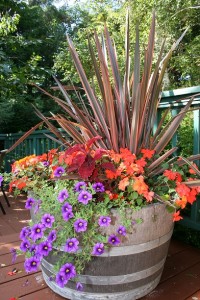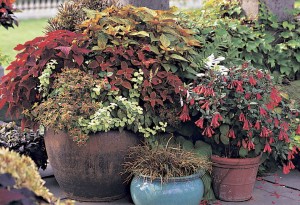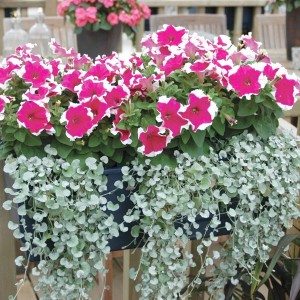
Planter boxes, wooden barrels, hanging baskets and large flowerpots are just some of the containers that can be used to create a stunning container garden display.
Growing Mixture
Make sure your planting medium drains rapidly but retains enough moisture to keep the roots evenly moist.
Compost will make an excellent potting soil. Check the requirements of the plants you grow to determine whether you will need to add sand.
If compost is not available, purchase a good quality potting mixture or make your own from equal parts of sand, loamy garden soil, and peat moss. Commercial potting mixes are usually slightly acidic, so you may want to add a little lime.
Most container gardeners have found that a “soilless” potting mix works best. In addition to draining quickly, “soilless” mixes are lightweight and free from diseases and weed seeds. These mixes can be purchased from garden centres.
When you add your soil to your container, leave a 2 inch space between the top of the soil and the top of the container. You will be able to add 1/2 inch or so of mulch later.
Sunlight
Your container garden will need at least five hours of direct sunlight each day, and many plants will benefit from even more. As a general rule, leafy vegetables such as cabbage and lettuce can tolerate the most shade, while root crops such as beets and carrots will need more sun. Fruiting vegetables such as tomatoes and cucumbers need the most sun. The amount of sunlight needed by flowers varies depending on the varieties grown.

Fertilizer
Since potting mixes drain water rapidly, fertilizer will be washed out of the container as you water.
Lighter mixes will require more frequent fertilizing than heavier mixes.
It’s a good idea to use a dilute liquid fertilizer with every other watering. Liquid fish emulsion or liquid seaweed are great plant boosters, but remember that you need to provide your plants with a variety of nutrients. Check the labels on the products in your garden centre to be sure that they contain a complete, balanced solution that includes trace elements.
 Watering
Watering
In an exposed location, container plants loose moisture quickly. Some plants will need to be watered daily, especially during hot, dry weather.

Choosing your container
- Avoid containers with narrow openings.
- Cheap plastic pots may deteriorate in UV sunlight and terracotta pots dry out rapidly.
- Glazed ceramic pots are excellent choices but require several drainage holes.
- Wooden containers are susceptible to rot. Redwood and cedar are relatively rot resistant and can be used without staining or painting. Avoid wood treated with creosote or other toxic compounds since the vapours can damage the plants. One advantage of wooden containers is that they can be built to sizes and shapes that suit the location.
- Use containers between 15 and 120 quarts capacity. Small pots restrict the root area and dry out very quickly. The size and number of plants to be grown will determine the size of the container used. Deep rooted vegetables require deep pots.
- Make sure your pot has adequate drainage. Holes should be 1/2 inch across. Line the base of the pot with newspaper to prevent soil loss.
- In hot climates use light-coloured containers to lessen heat absorption and discourage uneven root growth.
- Set containers on bricks or blocks to allow free drainage.
- Line hanging baskets with sphagnum moss (or similar substitute) for water retention. Keep baskets away from afternoon sun.
- If you choose clay pots, remember that clay is porous and water is lost from the sides of the container. Plants in clay pots should be monitored closely for loss of moisture.
![]()